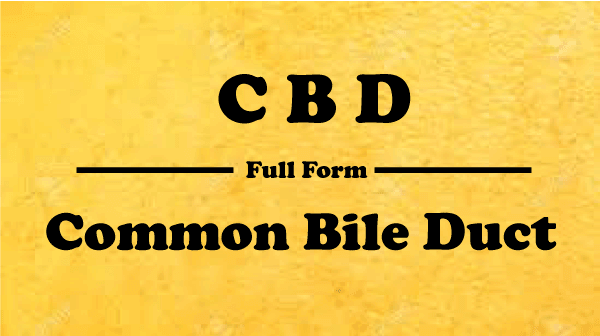What is the full form of CBDCBD: Common Bile DuctCBD stands for Common Bile Duct. The cystic duct and common hepatic duct combine to form the common bile duct (CBD), sometimes known as the bile duct. The common bile duct is a tube that passes through the pancreas and delivers bile up into the upper portion of the small intestine from the liver and gallbladder. The common hepatic duct from the liver, the gallbladder, and the cystic duct combine to form this biliary duct. It is created when the common hepatic duct and cystic duct combine, and it joins the pancreatic duct at its terminus to form the ampulla of Vater. The sphincter of Oddi controls how much bile enters the small intestine from the ampulla of Vater. Newly produced bile from the liver is compelled into storage in the gallbladder when the sphincter of Oddi closes. When the bile is released, it enters the duodenum where it assists in digestion while being combined with pancreatic secretions. The common bile duct's primary job is to transport bile. 
TerminologyIt is not possible to determine with certainty in ultrasound imaging where the cystic duct connects to the common hepatic duct to produce the common bile duct (CBD). Therefore, the term "common duct" is used to refer to both the common hepatic and common bile ducts (CD). The tiny channel created by the union of the pancreatic and common bile ducts is referred to as the common duct in Gray's Anatomy. Gross and Ultrasound AnatomyIn adults, the internal diameter of the CBD is about 6-7 mm, and its length is roughly 8 cm. Near the ampulla of Vater, it joins the pancreatic duct, which subsequently empties into the second section of the duodenum via the main duodenal papilla. It is significant that for many years, the CHD (Chronic Hepatic Disorder) was mistakenly referred to as CBD in radiological literature. Because of this, the commonly used normal value of 6 mm for adults (measured by ultrasonography, usually from the inner aspect of the wall to the inner aspect of the wall) usually relates to CHD. The porta hepatis, which is often parallel and anterior to the portal vein, is the optimum place to measure the CHD while the patient is fasting. 7 mm has lately been proposed by some researchers as the ideal cut-off. Since the diameter of the actual CBD is much more variable, it is challenging to determine a trustworthy cut-off value. Ultrasonography usually detects it more inferiorly after it has left the porta and is moving in the direction of the pancreas. Arterial SupplyA network of arteries, including
Bile travels in the following sequence:
The function of the Biliary SystemSome of the biliary system's key responsibilities include the following:
Bile salt is a chemical that actually facilitates the breakdown and absorption of lipids. Bile, which the body excretes in the form of faeces, gives faeces their dark brown colour.
Next TopicFull Form
|
 For Videos Join Our Youtube Channel: Join Now
For Videos Join Our Youtube Channel: Join Now
Feedback
- Send your Feedback to [email protected]
Help Others, Please Share










